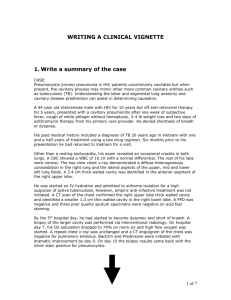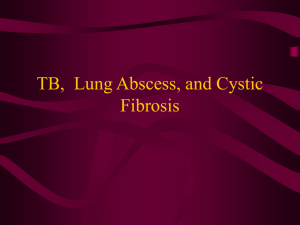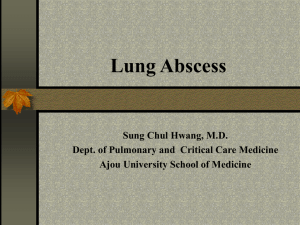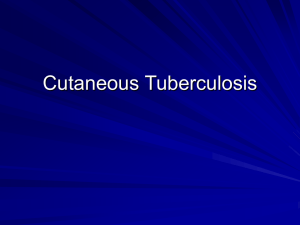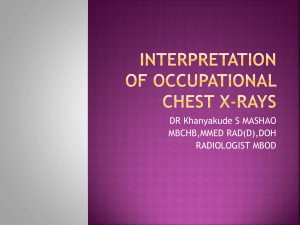Pulmonary TB radiology
advertisement
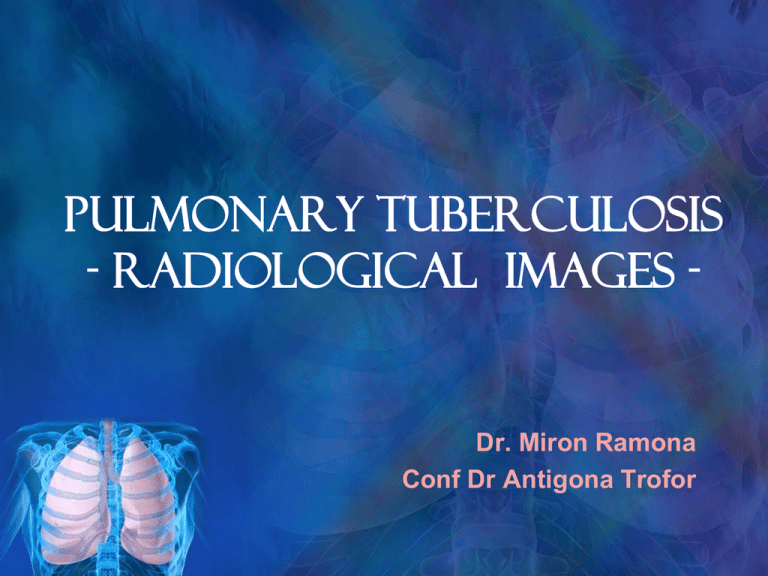
PULMONARY TUBERCULOSIS - RADIOLOGICAL IMAGES - Dr. Miron Ramona Conf Dr Antigona Trofor TUBERCULOSIS RADIOLOGY • Pulmonary tuberculosis, especially postprimary disease, nearly always causes abnormalities on chest radiographs. • Typically, the disease is parenchymal without nodal enlargement, and it manifests as cavitary lesions. • Upper-lobe involvement with cavitation and the absence of lymphadenopathy are helpful in distinguishing postprimary TB from primary TB. • In addition to the usually involved pulmonary segments— namely, the apical or posterior segments of the upper lobe or the superior segment of a lower lobe—anterior or basal segments may be involved in as many as 75% of cases. http://emedicine.medscape.com/article/358735-imaging PRIMARY TUBERCULOSIS RADIOLOGY • Radiographic screening for active TB in high-risk populations may demonstrate findings consistent with prior and/or current infection. • A Ghon focus refers to the initial site of parenchymal involvement at the time of first infection; • A Ranke complex is the combination of a Ghon focus and enlarged or calcified lymph nodes; • Lymphadenopathy is the radiologic hallmark of primary TB • Simon focus are apical nodules that are often calcified and result from hematogenous seeding at the time of initial infection PRIMARY PULMONARY TB • Initial pulmonary lesions GOHN-RANKE complex • Focus Gohn • Lymphangitis Ranke Complex • Lymphadenopathy • Image in “halter” Afect Adenita Limfangita Complexul Ranke Complexul primar Ranke: 1. GOHN focus (alveolitis)=basal subpleural nodular opacities (most often on right), flou contour 2. Lymphangitis: radiological expression, in some case appear fibrosis; fine linear opacities that connect the Gohn focus with hilum 3. Homolateral adenopathy: hilary, interbronchial or paratracheal rounded shape, massive polyciclic aspect, 3 2 1 Complex forms • Excavation of caseous alveolitis focus– primary cavern (cavity) transparent thin wall or anfractuous circumscribed, usually localized on the basal or middle lung fields, is accompanied by hilary adenopathy. • Voluminous adenophaties: cause ventilation modifications by extrabronchial compression, obstructive emphysema or systematized atelectasis Vouluminous right hilar adenopathy Segmental atelectasis in upper right lobe Complicated forms Large cavitary tuberculosis with forms: A. Pneumonia: triangular opacity - Can do to excavation Is accompanied by adenopathy Pneumonie TB lob superior drept B. Bronchopneumonia: Macronodulare alveolar opacities, various sizes, unequal distribution, with a tendency to confluence Associated adenopathies! Right paratracheal adenopathy Miliary nodules C. Miliary tuberculosis - Complication of Primary TB Radiological: miliary opacities with diameter < 3 mm, equal in size, homogeneous distribution Secondary tuberculosis • Occurs due to reactivation of primary tuberculosis • Reactivation of fibrotic lesions from apical territory • Reinfection by exogenous contamination Can occur after primary infection, Radiology- polymorphic semiology! Alveolar opacities systematized/nonsystematized; Nodular images, cavitary lesions, fibrous lesions, associated lesions The affected territories predilection: dorsal and apical segments of upper lobes and apical segments of lower lobes! 1. INFILTRATIVE TUBERCULOSIS 2. PLEURAL TB 3. CAVITARY CHRONIC TUBERCULOSIS 4. MYLIAR TUBERCULOSIS 5. FIBROTIC TUBERCULOSIS 6. TUBERCULOMA 1. INFILTRATIVE TUBERCULOSIS - Lesions of exudative alveolitis - Early infiltrates localize subclavicular - RADIOLOGY: NODULAR INFILTRATE ROUND INFILTRATE(ASSMAN) NEBULOUS INFILTRATE SEGMENTAL INFILTRATE Beginning of secondary TB can be: pneumonia, lobar or segmental opacities , bronchopneumoni Nodular infiltrate LUL infiltrative TB RUL Bilateral INFILTRATIVE LESIONS Disseminated nodular opacities in both lung fields, most commonly in middle and basal lung fields, moderate intensity, different size, shape removed, the tendency to confluence TB Bronchopneumonia Triangular opacity localized RUL TB Pneumonia Segmental infiltrate occupying almost the entire RUL and central tendency to excavation Massive left pneumonia – etiology TB Opacity nonhomogeneous RUL Pneumonia LUL TB PLEURAL EFFUSION In a patient with pleural exudate, TB is the first etiology to be taken into consideration! Radiological aspect of cavities(caverns) depends on the stage in which there are: Cavity grade 1 Cavity grade 2 Cavity grade 3 Cavity grade 1: Lucency (darkened area) within the lung parenchyma, with or without irregular margins CAVITY GRADE 2 :wall has its own thin, elastic, net contour Cavern with net wall localized RUL subclavicular Cavity grade 2 Between cavern and hilum- drainage bronchia Cavity grade 2 Cavity grade 3: old cavity, net shaped, wall fibrosis, cavitary sclerosis may be due to irregular shape, around the cavity disabling injuries. Calcification can exist around a cavity. Cavity grade 3 Old cavity, net contour, fibrosis of wall, sclerosis around cavity Radiological aspects of cavitary TB Multiple cavities in different stages of evolution Radiological aspects of cavitary TB Radiological aspects of cavitary TB Radiological aspects of cavitary TB small, multiple aspects in different stages of evolution Complications of cavitary • SEROFIBRINOUS PLEURESY • PACHIPLEURITIS(PLEURAL ADHESIONS) (AFTER RESORBTION OF EXUDATE) • PLEURAL EMPYEMA (INFECTION OF EXUDATE) • PARTIAL/TOTAL SPONTANEOUS PNEUMOTHORAX • BRONCHOGENIC DISEMINATIONS Complications of cavitary TB TB infiltrative lesions of RUL Mixed image horizontal line of the air-fluid level right hemithorax PLEURAL EMPYEMA Complications of cavitary TB •TB left empyema •Infiltrative lesions of right lung Complications of cavitary TB Pulmonary hiperlucency design collapsed lung to hilum (right lung field), large infiltrative lesions (left lung field) Complications of cavitary TB •Bilateral infiltrative lesions •RIGHT Pneumothorax Complications of cavitary TB •Bilateral infiltrative lesions • Right hydropneumothorax Complications of cavitary TB – bronchogenic dissemination Micronodular opacities, diffuse shape, vaguely defined, tendency to confluence to delimit small areas excavated ” Complications of cavitary TB – bronchogenic dissemination Bronchogenic dissemination from RUL to LIL (disemination type “Cardis”) Complications of cavitary TB – bronchogenic dissemination Hiperlucency excluding left lung, with attraction of trachea to the left, ascension compensatory of the diaphragm, hyperinflation of contralateral lung, right lung shows extensive infiltrative lesions and a cavity to the apex Images - multi-drug resistance TB Miliary TB - miliary nodules distributed homogenous in both lung fields POSTUBERCULOSIS FIBROSIS • Retraction of LUL with fibrous lesions extended to right lung • Basal left pachipleuritis FIBROTHORAX -The final process of sclerosis that interested entirely the lung • Sclerosis of right lung • Retraction of left hemithorax • Nodular lesions of left lung 5. Tuberculoma - Radiological: round, oval, encapsulated opacity, homogeneous or heterogeneous structure, net shape, can be solitary or multiple lesions - Seriate radiographs show stability in time!
